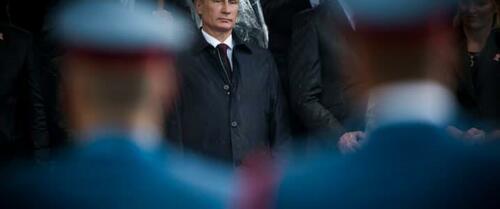
Authored by The Jamestown Foundation via OilPrice.com,
-
Russia is looking to grow the size of its armed forces to 1.5 million by the end of 2026.
-
According to the Russian population census of 2020–2021, the number of men 18–26 years old in Russia was around 7.21 million in 2021.
-
The number of young men in Russia is inevitably decreasing, presenting a challenge that make realizing its military ambitions impossible.
In December 2022, the Russian Ministry of Defense announced its ambitious plan for increasing the size of the Russian Armed Forces to 1.5 million personnel by the end of 2026. To this, the number of contracted soldiers within the Russian Armed Forces has to be increased significantly as well: to 521,000 by the end of 2023 and 695,000 by the end of 2026, adjusted from the previous plan of increasing this number from 405,000 in 2020 to 500,000 by 2027. Besides this, the conscription system will also be adjusted, with the age range for conscription being changed from 18–27 years old (at the moment, Russian men are not conscripted once they reach age 27) to 21–30 years old (Rg.ru, March 25, 2020; Mil.ru, December 21, 2022).
Recently, this author estimated that the only hypothetical way for realizing the planned increase would be a massive campaign of coercion for military service in Russia: from forcing young drafted soldiers to sign two-year service contracts to extending the network of military training centers within the universities, among other strategies (see EDM, January 6). However, a more serious issue looks to restrain the planned increase in the Russian Armed Forces faces—namely, Russia’s mounting demographic challenges (see EDM, January 10).
According to the Russian population census of 2020–2021, the number of men 18–26 years old in Russia was around 7.21 million in 2021. Using this census data, the number of men 18–26 years old will decrease to 7.18 million in 2023 and should then slightly increase to 7.22 million in 2026. Moreover, those who will be between the ages of 18 and 26 in 2023 are the same people who will be 21–29 years old in 2026, when the new conscription rules should be functioning (Rosstat.gov.ru, accessed February 16).
Yet, in fact, these projected numbers should be lower as annual mortality rates count 1,700–1,900 for those 10–14 years old (here and further, the mortality rates include both males and females, but the share of boys always exceeds 50 percent); 4,000–4,200 for those 15–19 years old; and 6,500–8,000 for those 20–24 years old (Rosstat.gov.ru, June 21, 2022).
For comparison, according to the 2010 census, about 10.6 million men ages 18 to 26 resided in Russia and about 12 million men of the same age group, according to the 2022 population census. Considering the planned increase of the conscription age, less than 7.16 million men ages 21 to 29 will be present in Russia in 2030 (Rosstat.gov.ru, accessed February 16).
Briefly speaking, the number of young men in Russia is inevitably decreasing. In previous decades, the Russian military leadership tried to take into consideration the long-term consequences of this process. For instance, the seasonal conscription in 2002 counted around 160,000–170,000 soldiers, and the spring conscription six years later numbered 133,000 soldiers (Iz.ru, April 25, 2002; RBC, October 17, 2002; Gazeta.ru, April 1, 2008). At that time, the term for conscripted military service was two years.
However, in 2008, when the term for military service was reduced from two years to one, the Russian Ministry of Defense tried to increase the number of drafted soldiers. In this way, the 2008 fall conscription enlisted 219,000 soldiers, the 2009 spring conscription numbered 305,000 soldiers and, during the further seasonal conscription campaigns of 2009 and 2010, around 270,000–280,000 soldiers were drafted (RIA Novosti, October 2, 2008; RBC, April 1, 2009; RIA Novosti, July 16, 2010). Thus, as the demographic of young Russians within the country began to dwindle, the total number of conscripted soldiers decreased from 640,000–660,000 to 540,000–560,000 during the 2000s.
Then, from 2012 to 2022, the number of soldiers drafted during each conscription campaign decreased from 200,000 in the spring of 2011 to an average of 130,000–140,000 (RBC, April 1, 2011; Rg.ru, December 31, 2021). Meanwhile, the number of contracted soldiers (including sergeants and noncommissioned officers) increased from 150,000 in 2010 to 405,000 in 2020 (Interfax, June 9, 2010; Rg.ru, March 25, 2020)—though, during these years, the number of conscripted soldiers and the number of contracted soldiers represented overlapping sets. That means the total number of soldiers, both drafted and contracted, decreased from almost 700,000 in 2010 to between 560,000 and 600,000 at the beginning of the 2020s.
In addition, it must be mentioned here that the total labor pool in Russia, made up of those people who should feed into the armed forces, also decreased from 93.1 million in 2010 to 89.1 million in 2020. And the number of those employed decreased from 71.5 million in 2010 to 69.5 million in 2020 (Rosstat.gov.ru, accessed February 16).
Consequently, the planned increase for personnel in the Russian Armed Forces seems to be impossible within the current demographic, economic and even political circumstances. The threshold of 695,000 contracted soldiers by 2027 means that one in ten Russian men between the ages of 21 and 30 could be called up to active service at any moment. In truth, this increase would only be possible if Russia was a truly democratic federation facing an existential foreign threat. Another option would be if Russia drafted young women together with men and those women signed formal service contracts—though, given the domestic demographic problems, this option looks even more impossible in Russia. As a result, the Russian Ministry of Defense may believe that it can close the gap by recruiting young migrants from Central Asia in exchange for Russian citizenship, which adds another dimension to Russia’s growing desperation in the face of declining demographics at home and manpower shortages in Ukraine.
Authored by The Jamestown Foundation via OilPrice.com,
-
Russia is looking to grow the size of its armed forces to 1.5 million by the end of 2026.
-
According to the Russian population census of 2020–2021, the number of men 18–26 years old in Russia was around 7.21 million in 2021.
-
The number of young men in Russia is inevitably decreasing, presenting a challenge that make realizing its military ambitions impossible.
In December 2022, the Russian Ministry of Defense announced its ambitious plan for increasing the size of the Russian Armed Forces to 1.5 million personnel by the end of 2026. To this, the number of contracted soldiers within the Russian Armed Forces has to be increased significantly as well: to 521,000 by the end of 2023 and 695,000 by the end of 2026, adjusted from the previous plan of increasing this number from 405,000 in 2020 to 500,000 by 2027. Besides this, the conscription system will also be adjusted, with the age range for conscription being changed from 18–27 years old (at the moment, Russian men are not conscripted once they reach age 27) to 21–30 years old (Rg.ru, March 25, 2020; Mil.ru, December 21, 2022).
Recently, this author estimated that the only hypothetical way for realizing the planned increase would be a massive campaign of coercion for military service in Russia: from forcing young drafted soldiers to sign two-year service contracts to extending the network of military training centers within the universities, among other strategies (see EDM, January 6). However, a more serious issue looks to restrain the planned increase in the Russian Armed Forces faces—namely, Russia’s mounting demographic challenges (see EDM, January 10).
According to the Russian population census of 2020–2021, the number of men 18–26 years old in Russia was around 7.21 million in 2021. Using this census data, the number of men 18–26 years old will decrease to 7.18 million in 2023 and should then slightly increase to 7.22 million in 2026. Moreover, those who will be between the ages of 18 and 26 in 2023 are the same people who will be 21–29 years old in 2026, when the new conscription rules should be functioning (Rosstat.gov.ru, accessed February 16).
Yet, in fact, these projected numbers should be lower as annual mortality rates count 1,700–1,900 for those 10–14 years old (here and further, the mortality rates include both males and females, but the share of boys always exceeds 50 percent); 4,000–4,200 for those 15–19 years old; and 6,500–8,000 for those 20–24 years old (Rosstat.gov.ru, June 21, 2022).
For comparison, according to the 2010 census, about 10.6 million men ages 18 to 26 resided in Russia and about 12 million men of the same age group, according to the 2022 population census. Considering the planned increase of the conscription age, less than 7.16 million men ages 21 to 29 will be present in Russia in 2030 (Rosstat.gov.ru, accessed February 16).
Briefly speaking, the number of young men in Russia is inevitably decreasing. In previous decades, the Russian military leadership tried to take into consideration the long-term consequences of this process. For instance, the seasonal conscription in 2002 counted around 160,000–170,000 soldiers, and the spring conscription six years later numbered 133,000 soldiers (Iz.ru, April 25, 2002; RBC, October 17, 2002; Gazeta.ru, April 1, 2008). At that time, the term for conscripted military service was two years.
However, in 2008, when the term for military service was reduced from two years to one, the Russian Ministry of Defense tried to increase the number of drafted soldiers. In this way, the 2008 fall conscription enlisted 219,000 soldiers, the 2009 spring conscription numbered 305,000 soldiers and, during the further seasonal conscription campaigns of 2009 and 2010, around 270,000–280,000 soldiers were drafted (RIA Novosti, October 2, 2008; RBC, April 1, 2009; RIA Novosti, July 16, 2010). Thus, as the demographic of young Russians within the country began to dwindle, the total number of conscripted soldiers decreased from 640,000–660,000 to 540,000–560,000 during the 2000s.
Then, from 2012 to 2022, the number of soldiers drafted during each conscription campaign decreased from 200,000 in the spring of 2011 to an average of 130,000–140,000 (RBC, April 1, 2011; Rg.ru, December 31, 2021). Meanwhile, the number of contracted soldiers (including sergeants and noncommissioned officers) increased from 150,000 in 2010 to 405,000 in 2020 (Interfax, June 9, 2010; Rg.ru, March 25, 2020)—though, during these years, the number of conscripted soldiers and the number of contracted soldiers represented overlapping sets. That means the total number of soldiers, both drafted and contracted, decreased from almost 700,000 in 2010 to between 560,000 and 600,000 at the beginning of the 2020s.
In addition, it must be mentioned here that the total labor pool in Russia, made up of those people who should feed into the armed forces, also decreased from 93.1 million in 2010 to 89.1 million in 2020. And the number of those employed decreased from 71.5 million in 2010 to 69.5 million in 2020 (Rosstat.gov.ru, accessed February 16).
Consequently, the planned increase for personnel in the Russian Armed Forces seems to be impossible within the current demographic, economic and even political circumstances. The threshold of 695,000 contracted soldiers by 2027 means that one in ten Russian men between the ages of 21 and 30 could be called up to active service at any moment. In truth, this increase would only be possible if Russia was a truly democratic federation facing an existential foreign threat. Another option would be if Russia drafted young women together with men and those women signed formal service contracts—though, given the domestic demographic problems, this option looks even more impossible in Russia. As a result, the Russian Ministry of Defense may believe that it can close the gap by recruiting young migrants from Central Asia in exchange for Russian citizenship, which adds another dimension to Russia’s growing desperation in the face of declining demographics at home and manpower shortages in Ukraine.
Loading…





